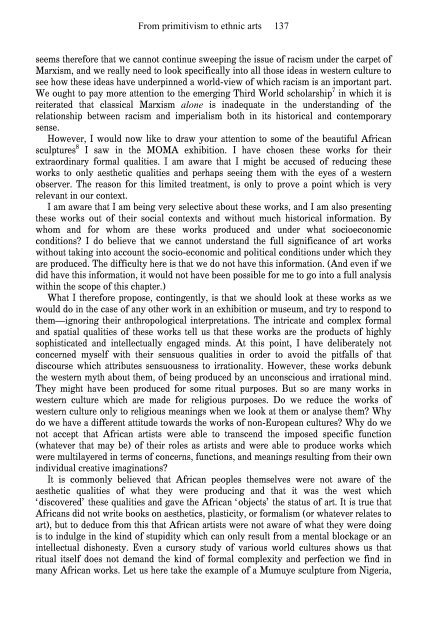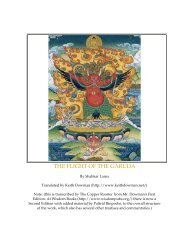Hiller - The Myth of Primitivism. Perspectives on Art - Esoteric Online
Hiller - The Myth of Primitivism. Perspectives on Art - Esoteric Online
Hiller - The Myth of Primitivism. Perspectives on Art - Esoteric Online
Create successful ePaper yourself
Turn your PDF publications into a flip-book with our unique Google optimized e-Paper software.
From primitivism to ethnic arts 137<br />
seems therefore that we cannot c<strong>on</strong>tinue sweeping the issue <str<strong>on</strong>g>of</str<strong>on</strong>g> racism under the carpet <str<strong>on</strong>g>of</str<strong>on</strong>g><br />
Marxism, and we really need to look specifically into all those ideas in western culture to<br />
see how these ideas have underpinned a world-view <str<strong>on</strong>g>of</str<strong>on</strong>g> which racism is an important part.<br />
We ought to pay more attenti<strong>on</strong> to the emerging Third World scholarship 7 in which it is<br />
reiterated that classical Marxism al<strong>on</strong>e is inadequate in the understanding <str<strong>on</strong>g>of</str<strong>on</strong>g> the<br />
relati<strong>on</strong>ship between racism and imperialism both in its historical and c<strong>on</strong>temporary<br />
sense.<br />
However, I would now like to draw your attenti<strong>on</strong> to some <str<strong>on</strong>g>of</str<strong>on</strong>g> the beautiful African<br />
sculptures 8 I saw in the MOMA exhibiti<strong>on</strong>. I have chosen these works for their<br />
extraordinary formal qualities. I am aware that I might be accused <str<strong>on</strong>g>of</str<strong>on</strong>g> reducing these<br />
works to <strong>on</strong>ly aesthetic qualities and perhaps seeing them with the eyes <str<strong>on</strong>g>of</str<strong>on</strong>g> a western<br />
observer. <str<strong>on</strong>g>The</str<strong>on</strong>g> reas<strong>on</strong> for this limited treatment, is <strong>on</strong>ly to prove a point which is very<br />
relevant in our c<strong>on</strong>text.<br />
I am aware that I am being very selective about these works, and I am also presenting<br />
these works out <str<strong>on</strong>g>of</str<strong>on</strong>g> their social c<strong>on</strong>texts and without much historical informati<strong>on</strong>. By<br />
whom and for whom are these works produced and under what socioec<strong>on</strong>omic<br />
c<strong>on</strong>diti<strong>on</strong>s? I do believe that we cannot understand the full significance <str<strong>on</strong>g>of</str<strong>on</strong>g> art works<br />
without taking into account the socio-ec<strong>on</strong>omic and political c<strong>on</strong>diti<strong>on</strong>s under which they<br />
are produced. <str<strong>on</strong>g>The</str<strong>on</strong>g> difficulty here is that we do not have this informati<strong>on</strong>. (And even if we<br />
did have this informati<strong>on</strong>, it would not have been possible for me to go into a full analysis<br />
within the scope <str<strong>on</strong>g>of</str<strong>on</strong>g> this chapter.)<br />
What I therefore propose, c<strong>on</strong>tingently, is that we should look at these works as we<br />
would do in the case <str<strong>on</strong>g>of</str<strong>on</strong>g> any other work in an exhibiti<strong>on</strong> or museum, and try to resp<strong>on</strong>d to<br />
them—ignoring their anthropological interpretati<strong>on</strong>s. <str<strong>on</strong>g>The</str<strong>on</strong>g> intricate and complex formal<br />
and spatial qualities <str<strong>on</strong>g>of</str<strong>on</strong>g> these works tell us that these works are the products <str<strong>on</strong>g>of</str<strong>on</strong>g> highly<br />
sophisticated and intellectually engaged minds. At this point, I have deliberately not<br />
c<strong>on</strong>cerned myself with their sensuous qualities in order to avoid the pitfalls <str<strong>on</strong>g>of</str<strong>on</strong>g> that<br />
discourse which attributes sensuousness to irrati<strong>on</strong>ality. However, these works debunk<br />
the western myth about them, <str<strong>on</strong>g>of</str<strong>on</strong>g> being produced by an unc<strong>on</strong>scious and irrati<strong>on</strong>al mind.<br />
<str<strong>on</strong>g>The</str<strong>on</strong>g>y might have been produced for some ritual purposes. But so are many works in<br />
western culture which are made for religious purposes. Do we reduce the works <str<strong>on</strong>g>of</str<strong>on</strong>g><br />
western culture <strong>on</strong>ly to religious meanings when we look at them or analyse them? Why<br />
do we have a different attitude towards the works <str<strong>on</strong>g>of</str<strong>on</strong>g> n<strong>on</strong>-European cultures? Why do we<br />
not accept that African artists were able to transcend the imposed specific functi<strong>on</strong><br />
(whatever that may be) <str<strong>on</strong>g>of</str<strong>on</strong>g> their roles as artists and were able to produce works which<br />
were multilayered in terms <str<strong>on</strong>g>of</str<strong>on</strong>g> c<strong>on</strong>cerns, functi<strong>on</strong>s, and meanings resulting from their own<br />
individual creative imaginati<strong>on</strong>s?<br />
It is comm<strong>on</strong>ly believed that African peoples themselves were not aware <str<strong>on</strong>g>of</str<strong>on</strong>g> the<br />
aesthetic qualities <str<strong>on</strong>g>of</str<strong>on</strong>g> what they were producing and that it was the west which<br />
‘discovered’ these qualities and gave the African ‘objects’ the status <str<strong>on</strong>g>of</str<strong>on</strong>g> art. It is true that<br />
Africans did not write books <strong>on</strong> aesthetics, plasticity, or formalism (or whatever relates to<br />
art), but to deduce from this that African artists were not aware <str<strong>on</strong>g>of</str<strong>on</strong>g> what they were doing<br />
is to indulge in the kind <str<strong>on</strong>g>of</str<strong>on</strong>g> stupidity which can <strong>on</strong>ly result from a mental blockage or an<br />
intellectual dish<strong>on</strong>esty. Even a cursory study <str<strong>on</strong>g>of</str<strong>on</strong>g> various world cultures shows us that<br />
ritual itself does not demand the kind <str<strong>on</strong>g>of</str<strong>on</strong>g> formal complexity and perfecti<strong>on</strong> we find in<br />
many African works. Let us here take the example <str<strong>on</strong>g>of</str<strong>on</strong>g> a Mumuye sculpture from Nigeria,




